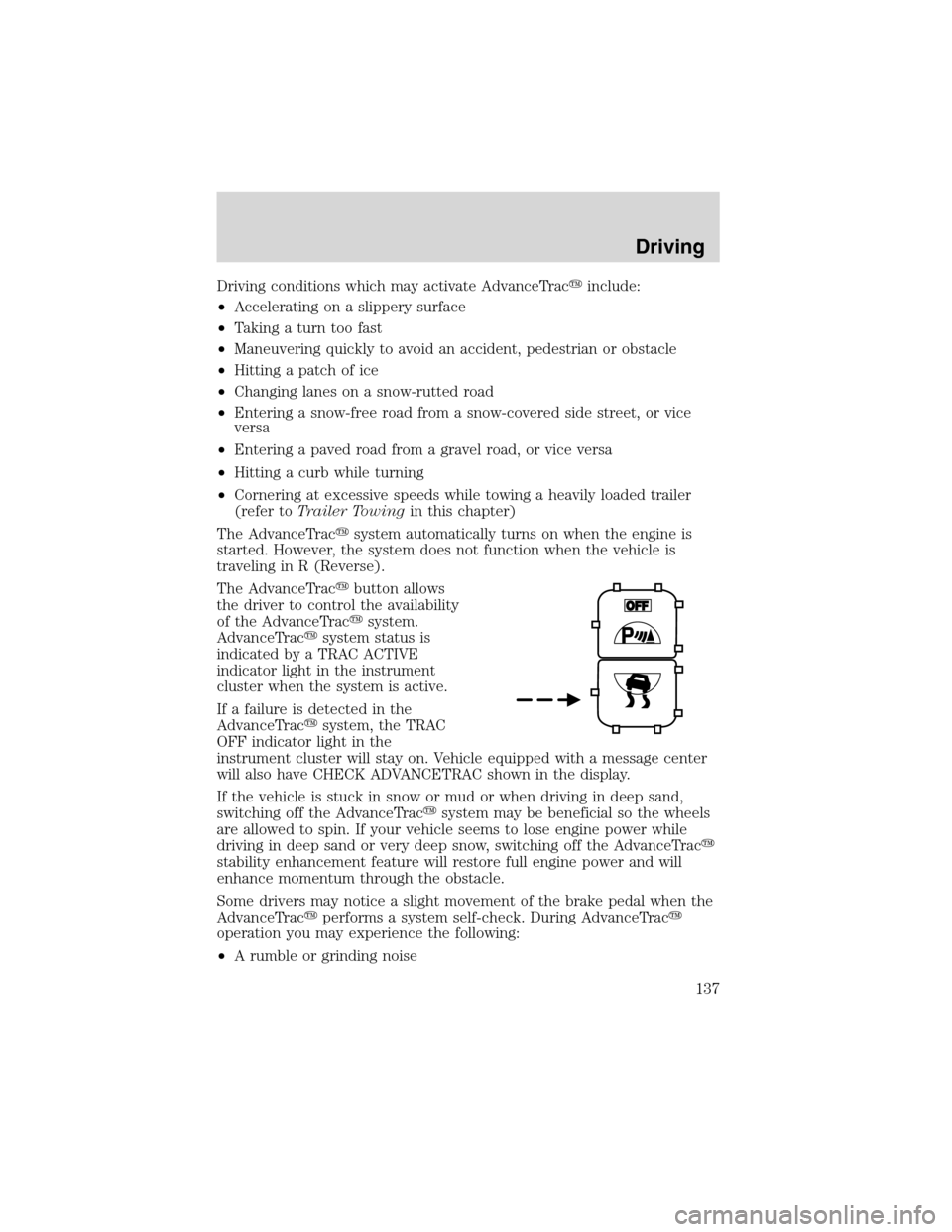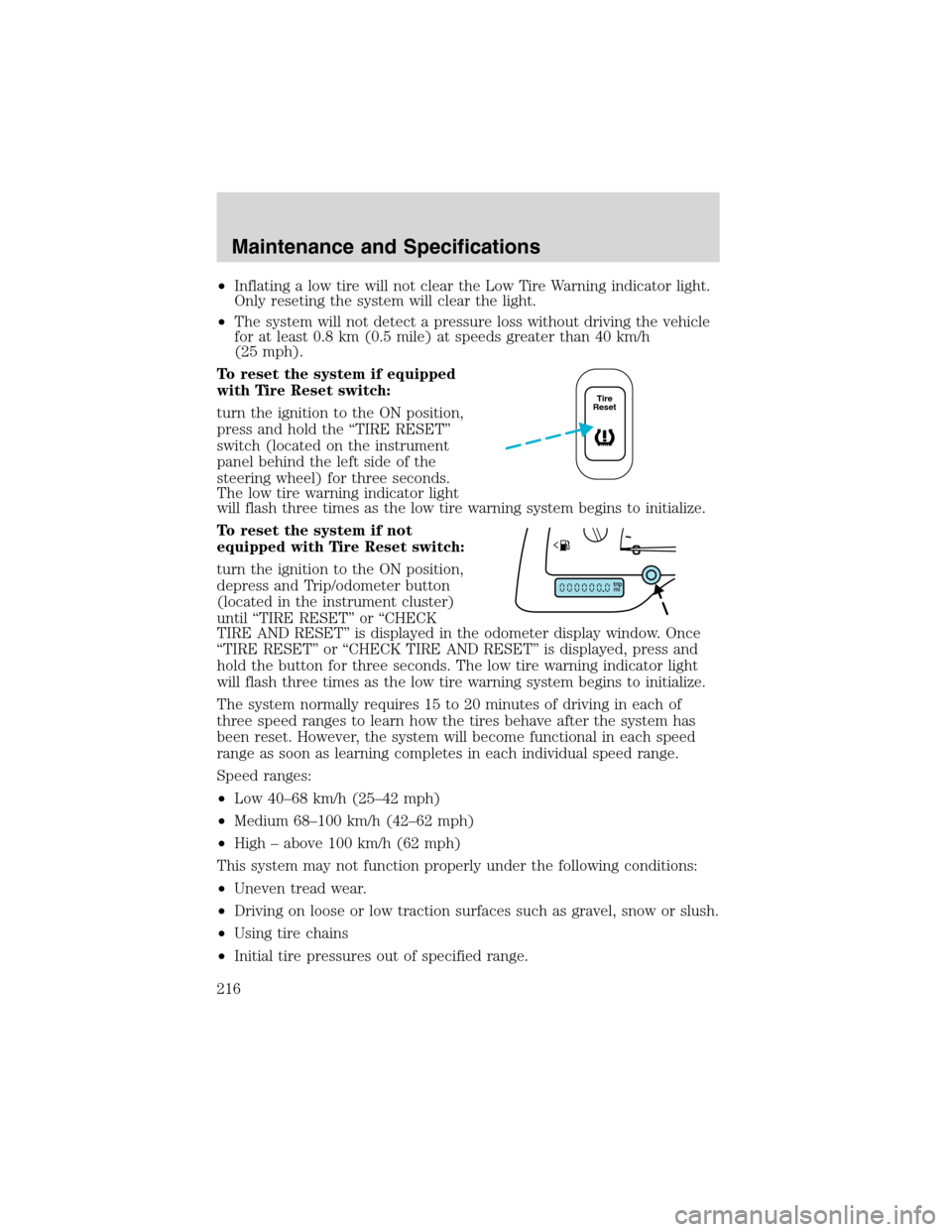Page 137 of 240

Driving conditions which may activate AdvanceTrac�include:
•Accelerating on a slippery surface
•Taking a turn too fast
•Maneuvering quickly to avoid an accident, pedestrian or obstacle
•Hitting a patch of ice
•Changing lanes on a snow-rutted road
•Entering a snow-free road from a snow-covered side street, or vice
versa
•Entering a paved road from a gravel road, or vice versa
•Hitting a curb while turning
•Cornering at excessive speeds while towing a heavily loaded trailer
(refer toTrailer Towingin this chapter)
The AdvanceTrac�system automatically turns on when the engine is
started. However, the system does not function when the vehicle is
traveling in R (Reverse).
The AdvanceTrac�button allows
the driver to control the availability
of the AdvanceTrac�system.
AdvanceTrac�system status is
indicated by a TRAC ACTIVE
indicator light in the instrument
cluster when the system is active.
If a failure is detected in the
AdvanceTrac�system, the TRAC
OFF indicator light in the
instrument cluster will stay on. Vehicle equipped with a message center
will also have CHECK ADVANCETRAC shown in the display.
If the vehicle is stuck in snow or mud or when driving in deep sand,
switching off the AdvanceTrac�system may be beneficial so the wheels
are allowed to spin. If your vehicle seems to lose engine power while
driving in deep sand or very deep snow, switching off the AdvanceTrac�
stability enhancement feature will restore full engine power and will
enhance momentum through the obstacle.
Some drivers may notice a slight movement of the brake pedal when the
AdvanceTrac�performs a system self-check. During AdvanceTrac�
operation you may experience the following:
•A rumble or grinding noise
Driving
137
Page 156 of 240

Fuse/Relay
LocationFuse Amp
RatingPassenger Compartment Fuse Panel
Description
11 15A Electric brake controller, Brake shift interlock
solenoid, Rear electronic module
12 20A Center high-mounted stop lamp
13 10A Right rear turn lamp, Left stop lamp, Left
rear park lamp
14 10A Autolamp sensor, Transmission overdrive
cancel switch, Front electronic module,
Compass module, Electrochromatic mirror,
PSD overhead console switch
15 20A Console power point
16 10A Cluster
17 20A Cigar lighter/Powerpoint, Datalink connector
18 15A Quarter Window Motors, RH window switch
backlighting, RH lock switch backlighting,
Master control switch (LH) backlighting,
Radio, VCP, Liquid Crystal Display (LCD),
Front electronic module
19 10A Starter interrupt relay (coil)
20—Not used
21—Not used
22 10A Heated Mirrors
23 20A Body power point, Auxiliary blower relay #1
and #2 coils
24—Not used
25 10A Radio (Anti-theft)
26 10A Air bag module, Passenger air bag
deactivated indicator, Passenger seat weight
pressure sensor ECU
27—Not used
28 10A Cluster
29 2A Speed control deactivation switch
Relay 1—Switched system power relay #4
Roadside Emergencies
156
Page 205 of 240

in the United States) because it may cause these problems to become
more pronounced. If the problems persist, see your dealer or a qualified
service technician.
It should not be necessary to add any aftermarket products to your fuel
tank if you continue to use high quality fuel of the recommended octane
rating. Aftermarket products could cause damage to the fuel system.
Repairs to correct the effects of using an aftermarket product in your
fuel may not be covered by your warranty.
Many of the world’s automakers
issued the World-wide Fuel Charter
that recommends gasoline
specifications to provide improved
performance and emission control
system protection for your vehicle.
Gasolines that meet the World-wide
Fuel Charter should be used when
available. Ask your fuel supplier
about gasolines that meet the
World-wide Fuel Charter. In Canada,
look for fuels that display theAuto Makers’Choice�logo.
Cleaner air
Ford endorses the use of reformulated“cleaner-burning”gasolines to
improve air quality.
Running out of fuel
Avoid running out of fuel because this situation may have an adverse
affect on powertrain components.
If you have run out of fuel:
•You may need to cycle the ignition from OFF to ON several times after
refueling, to allow the fuel system to pump the fuel from the tank to
the engine.
•Your“Check Engine”indicator may come on. For more information on
the“Check Engine”indicator, refer to theInstrument Cluster
chapter.
Fuel Filter
For fuel filter replacement, see your dealer or a qualified service
technician. Refer to the scheduled maintenance guide for the appropriate
intervals for changing the fuel filter.
Maintenance and Specifications
205
Page 216 of 240

•Inflating a low tire will not clear the Low Tire Warning indicator light.
Only reseting the system will clear the light.
•The system will not detect a pressure loss without driving the vehicle
for at least 0.8 km (0.5 mile) at speeds greater than 40 km/h
(25 mph).
To reset the system if equipped
with Tire Reset switch:
turn the ignition to the ON position,
press and hold the“TIRE RESET”
switch (located on the instrument
panel behind the left side of the
steering wheel) for three seconds.
The low tire warning indicator light
will flash three times as the low tire warning system begins to initialize.
To reset the system if not
equipped with Tire Reset switch:
turn the ignition to the ON position,
depress and Trip/odometer button
(located in the instrument cluster)
until“TIRE RESET”or“CHECK
TIRE AND RESET”is displayed in the odometer display window. Once
“TIRE RESET”or“CHECK TIRE AND RESET”is displayed, press and
hold the button for three seconds. The low tire warning indicator light
will flash three times as the low tire warning system begins to initialize.
The system normally requires 15 to 20 minutes of driving in each of
three speed ranges to learn how the tires behave after the system has
been reset. However, the system will become functional in each speed
range as soon as learning completes in each individual speed range.
Speed ranges:
•Low 40–68 km/h (25–42 mph)
•Medium 68–100 km/h (42–62 mph)
•High–above 100 km/h (62 mph)
This system may not function properly under the following conditions:
•Uneven tread wear.
•Driving on loose or low traction surfaces such as gravel, snow or slush.
•Using tire chains
•Initial tire pressures out of specified range.
Tire
Reset
Maintenance and Specifications
216
Page 228 of 240
Tire step
Travel equipment
All weather floor mats
Cargo organizer
Cargo logic—premium cargo organizer
Cellular phone holder
Cellular phone hands free ssytem with voice recognition
Console
Factory luggage rack adaptors (Bike, ski, etc.)
First aid kit
Framed luggage covers
Highway safety kit
Inside rear view mirror with compass (with and without temperature
display)
Luggage/cargo basket
Navigation system
Raised cross bars (roof rack)
Rear seat entertainment system (DVD)
Soft luggage cover
Trailer hitch (Class II)
Trailer hitch bars and balls
Trailer hitch mount bike carrier
Trailer hitch receiver cover
Trailer hitch wiring adaptor
Trailgate table/ adapter.
Protection and appearance equipment
Cargo liners, interior
Carpet floor mats
Door edge guards
Flat splash guards
Front end covers (full and mini)
Accessories
228
Page:
< prev 1-8 9-16 17-24